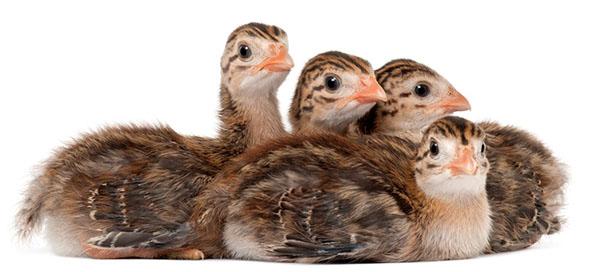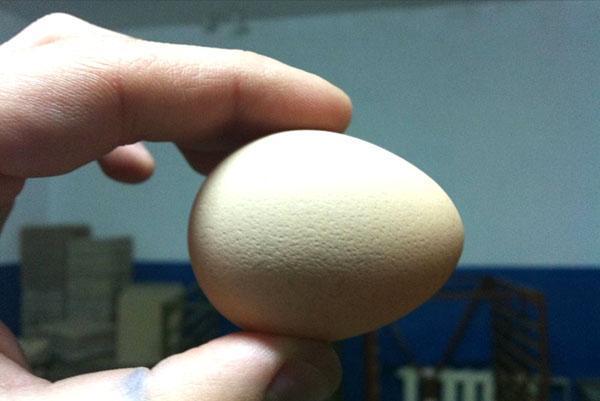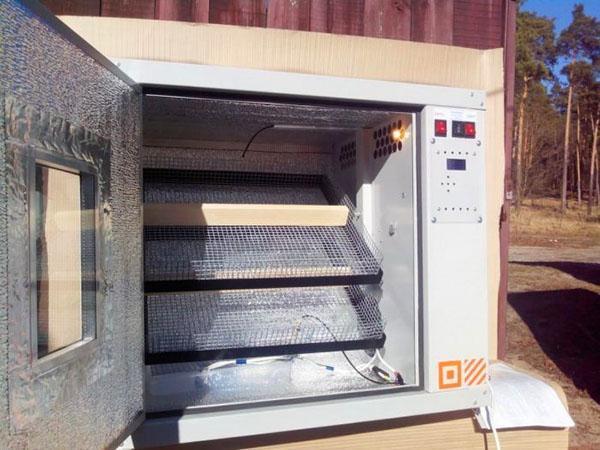How is the incubation of guinea fowls in home and farm breeding
 Beautiful birds with dietary meat, guinea fowl, resemble both chickens and turkeys. The parental instinct in the female is poorly developed, the incubation of guinea fowls or a lining under the chicken allows for offspring. The way of life of guinea fowl differs little from that of a chicken. They need the same diet, roosting chicken coop. Guinea fowls cannot stand dampness and cramped conditions. An adult bird weighs about 2 kg.
Beautiful birds with dietary meat, guinea fowl, resemble both chickens and turkeys. The parental instinct in the female is poorly developed, the incubation of guinea fowls or a lining under the chicken allows for offspring. The way of life of guinea fowl differs little from that of a chicken. They need the same diet, roosting chicken coop. Guinea fowls cannot stand dampness and cramped conditions. An adult bird weighs about 2 kg.
Read the article: temperature when incubating chicken eggs!
Requirements for eggs for incubation

Clean eggs collected before 11 a.m. are stored for no more than 8 days at a temperature of 8-120 C and humidity about 80%. Store the material in a dark place with a blunt end up. Eggs are placed in the incubator warmed to room temperature. Before filling the chamber, the eggs are cooked.
By weight, guinea fowl eggs are divided into groups:
- small - 38-40 g;
- medium - 41-44 g;
- large - 45-50 g.
The brood should be from one group by weight, according to this indicator, the regime is selected. The incubation guinea fowl egg is irradiated with quartz dumps for 5 minutes, killing microbes on the surface of the shell. At the factory, formaldehyde vapor is fed into the preparatory chamber. At home, eggs are treated with a solution of iodine or potassium permanganate. After all operations on the ovoscope, the integrity of the shell and the presence of the embryo are checked.
Often, domestic guinea fowl eggs have an uneven "marble" color. It has been noticed that the productivity of such material is low. Experts say that marbling is a sign that the embryo will not form.
The prepared material should have a standard shape, this affects the amount of air in the pug. It should be enough for the entire period of development of the embryo.
Incubator requirements
 The thermostat for incubating guinea fowl eggs at home provides temperature and humidity conditions for 28 days. In this case, the slightest deviation from the schedule can freeze the embryo. The mains device in the set must have a battery, to which it switches automatically in the absence of voltage in the line.
The thermostat for incubating guinea fowl eggs at home provides temperature and humidity conditions for 28 days. In this case, the slightest deviation from the schedule can freeze the embryo. The mains device in the set must have a battery, to which it switches automatically in the absence of voltage in the line.
The humidity in the chamber is maintained by the evaporator and automation, the readings of the wet and dry thermometer must be controlled. Incubator must be protected against overheating. A rise in temperature in one minute can kill the brood.
Regular air exchange in the thermostat is mandatory, it has holes for air circulation. Each egg, during incubation of guinea fowls, releases 3.5 liters of carbon dioxide and assimilates 4 liters of oxygen.
For automatic inversion, egg trays must be adapted to accommodate eggs with the blunt end up. For manual turning, eggs are laid sideways, marked for orientation. The best incubator is natural - guinea fowl.
Incubation mode table for hatching guinea fowls in an incubator
In the backyard, chickens have been successfully hatched for a long time in an incubator.For guinea fowls, the same device is suitable, but the mode of hatching chicks is different. Embryos are demanding on the microclimate in the chamber. The incubation of guinea fowl eggs at home is carried out according to the schedule:
| Incubation period | temperature | humidity | aeration |
| 1-2 | 37,8-38 | 65 | |
| 3-14 | 37,6 | 60 | 5 minutes |
| 15-24 | 37,5 | 50-55 | 8-10 minutes |
| 25 | 37,5 | 50 | 10 minutes |
| 26-28 | 37,0-37,2 | 68-70 |
Eggs are turned over 2-3 times a day. From day 26 until hatching, eggs are not disturbed. The process should take place in silence. From a sharp sound or impact, the embryo can freeze.
During the development of embryos, a lunge is made, not all eggs develop. In a frozen vessel with a protein mass, microorganisms multiply, a decay process occurs, as a result, the shell will not withstand the pressure and the chamber will be flooded with an infected mass. Removing eggs that have stopped developing in time is a must. During the incubation period of the guinea fowl, the development of the embryo is checked 4 times.
The ovoscope shines through the eggs and the observer sees the stages of embryo development. According to the standard, unfertilized eggs must be removed that have entered the incubator on the 8th day. On day 15, eggs are harvested, which have a blood ring on a dull orange background. The third revision is carried out after 24 days, removing frozen embryos. The incubation period of guinea fowls is 28 days.
At stage 4, the chicks feed on their own, absorbing the required amount of protein and yolk. But for this, high humidity must remain in the chamber. From the beginning of pecking, the humidity in the hatcher tray is increased by spraying the shell from a spray bottle. The turning of the eggs is stopped and the baby, squeaking, pecks on the shell himself. On the next day, he will bite the rim, breaking the shell in two. If the regime was not violated, the Caesars would be released from captivity together, some would immediately stand on their feet, others would gain strength lying down.
 Specialists and experienced poultry farmers describe in detail how to breed guinea fowls in an incubator. It is better to use the standard recommendation for the first time, but keep a regime diary. Over time, it will develop its own schedule.
Specialists and experienced poultry farmers describe in detail how to breed guinea fowls in an incubator. It is better to use the standard recommendation for the first time, but keep a regime diary. Over time, it will develop its own schedule.
Guinea fowl eggs keep well. The submarine grocery kit includes guinea-fowl eggs as a healing natural nutrient.
How to select guinea fowls for a parent flock
 During incubation, the guinea fowl loses 14% of the original egg weight. The larger the batch of eggs is laid, the stronger the offspring will come out. For growing, babies are taken from the brooder after they have been resting for 8-12 hours. The standard chick already stands well on its legs, reacts to tapping on the box. The baby's eyes shine, the tummy is tucked up, the fluff shines. The strongest princes will be distributed into families and continue the race. When breeding guinea fowls in an incubator, healthy chicks from the initial laying can be up to 60%, this is considered good performance.
During incubation, the guinea fowl loses 14% of the original egg weight. The larger the batch of eggs is laid, the stronger the offspring will come out. For growing, babies are taken from the brooder after they have been resting for 8-12 hours. The standard chick already stands well on its legs, reacts to tapping on the box. The baby's eyes shine, the tummy is tucked up, the fluff shines. The strongest princes will be distributed into families and continue the race. When breeding guinea fowls in an incubator, healthy chicks from the initial laying can be up to 60%, this is considered good performance.